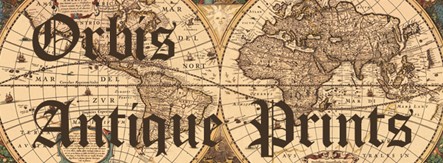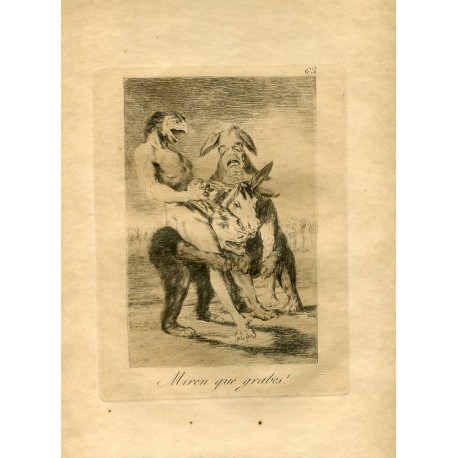Cart
0
Product
Products
(empty)
No products
To be determined
Shipping
0 €
Total
Product successfully added to your shopping cart
Quantity
Total
There are 0 items in your cart. There is 1 item in your cart.
Total products
Total shipping
To be determined
Total
Goya etching. Look how solemn they are! (Miren que grabes!). Plate 63 from The Caprices etching series, 1937 edition.
10033
Normal (with signs of normal use)
This edition was made by Rupérez in the Calcografía Nacional for the Ministerio de Instrucción Pública in 1937, during the Spanish Civil War.
Plate measures: 21,4x15,1 cms.
Sheet measures: 38x28,5 cms.
More
The present engraving has the number 19 on the back. The engraving has a embossed stamp with the initials 'CN' surrounded by a border which reads: Calcografia Nacional Ministerio de Instrucción Pública.
Five sets, numbered 1-5 were dedicated to Stalin, Mrs. Eleanor Rooselvet, and for the Republican President Azaña, President of the Republic, leaving two sets unaccounted for. Fifteen series numbered 6-20, on Imperial Japan paper were also issued. It appears that shortly after the outbreak of the Spanish Civil War, all Goya´s copperplates were going to be sent to Paris with a view to printing an edition there. The work was finally undertaken in the Calcografía. One of the first series issued in 1937 was gifted by the Spanish Embassy in London to the Victorian and Albert Museum, where it was exhibited. Thomas Harris states that this edition is a very well printed.
Condition: In good condition. It has litttle rust spots that do not affect the image as can be seen in the pictures.
'Miren que grabes!' (Plate 63 from Los Caprichos). This stamp corresponds to the thematic group of the "power of ignorance". Goya addresses this issue through the representation of two personifications of stupidity, with expressions of enormous placidity, which are mounted on figures with the head of donkeys, a symbol of the ignorance of the people who must endure the fantasies of these two monstrous characters. Contemporary commentaries allude to the atmosphere of the court and the abuses of authority promoted by those who compose it.
Los Caprichos are above all a satire conceived as a means to combat the vices of men and the absurdities of human behavior. Simplifying the series, we can group the prints around four major themes, all of them undoubtedly critical in tone. In the first of them, he addresses deception in relationships between man and woman: courtship as a common practice according to which modern man, busy with his various businesses, allowed his wife to be accompanied on his outings by a leading man; prostitution that denigrated and exploited the condition of both sexes; and unequal marriages or marriages of convenience, a common practice of his time and criticized by the enlightened. The satire of bad education and ignorance, the result of enlightened concern about this issue, is reflected in the Caprices that show the consequences of wrong teachings in children; false beliefs and superstitions produced by ignorance; and witchcraft as the supreme manifestation of lack of education and superstition. The condemnation of the vices rooted in society, and particularly in the clergy, also have a place: vanity, gluttony, laziness, lust or greed are shown to us in a caustic way in another group of prints. Finally, other Caprichos reveal their protest against the abuses of power: the Inquisition, the arrogance of the ruling classes, the exploitation of the people and the injustices of the law.
Reviews
No customer reviews for the moment.





